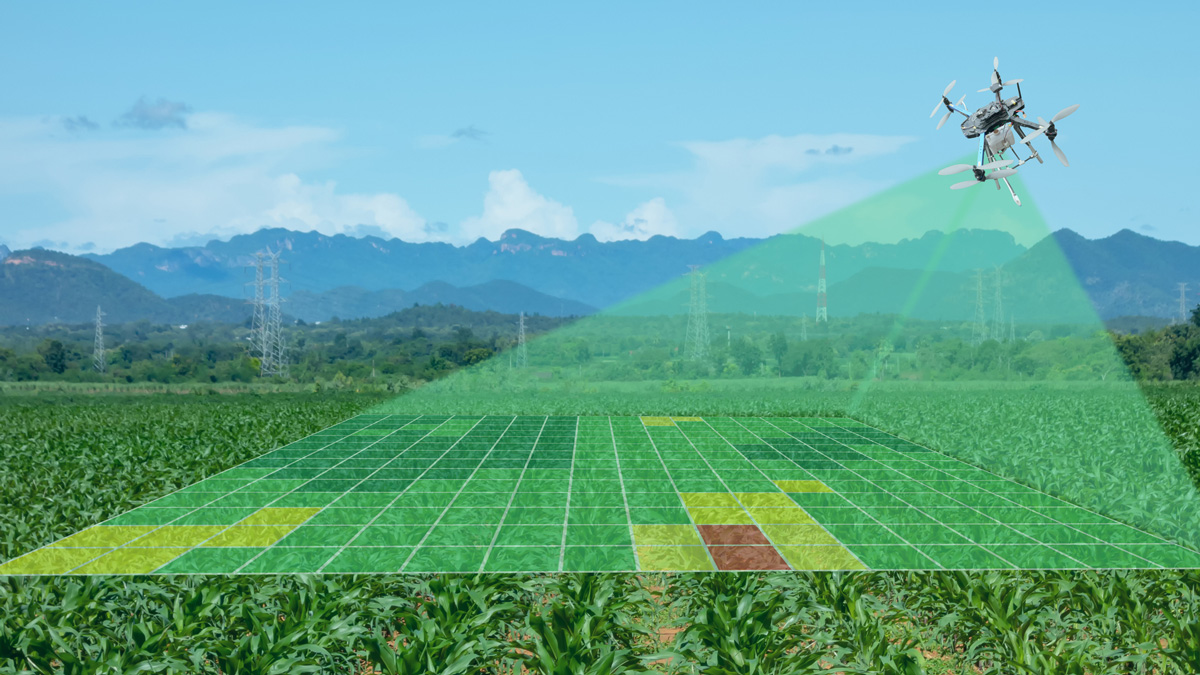Technology Enables a More Sustainable Agricultural Future
FIRST News
 By Christine Blank
By Christine Blank
Drones that can quickly identify crop problems and in-depth soil nutrient data are greatly improving efficiency and sustainability, say expert panelists during the FIRST session, “Agriculture Innovations Driving the Future of Food Stability.”
“Before we would have to walk every acre and we would have to cut those weeds by hand,” explains Meagan Kaiser, COO at Perry Agricultural Laboratory, and soil scientist and farmer-director for the United Soybean Board. “Now we’re able to use technology to be a little bit more efficient, a little bit better with our labor.”
“We’re using drones to fly over the fields … because there are some things that you can’t actually see very well from on the ground,” says Kaiser.
Farmers are also using satellite imagery to get a quick look at the crops’ health. Armed with that imagery, Kaiser explains that she will go into the fields and take tissue samples from areas that are less green. She can then compare those tissue samples with healthier areas to see what nutrients aren’t getting into the plant.
Soil nutrient data is invaluable and allows researchers to compare which input produced the overall healthier crop, Kaiser notes. “We are continually looking at, okay, we put nitrogen on this way on this part of the field and then put it on [with] another method on the other part of the field. Which one paid off?”
Farmers are committed to improving efficiencies and sustainability and reducing their land use impact, Kaiser and other panelists contend. For example, farmers are reducing soil erosion by practicing minimal tillage and utilization of cover crops.
They are also monitoring the fuel efficiency of farm equipment. “On my phone, I can see every vehicle on our farm and how much fuel, what the efficiency level was,” Kaiser explains. “I can take my entire fuel usage and see what my greenhouse gas emissions are.” Being able to easily measure the impact helps farmers strategize on what they can do to minimize it going forward.
Pam Smith, nutritionist, culinary consultant, and the panel’s moderator, agrees with farmers’ sustainability initiatives and innovations. “Not only is today’s farmer focused on the yield of the crop, the health of the crop, and the vitality of the field, but they are also very concerned about sustainability,” says Smith. “It’s not just better crops; it’s better sustainability.”
Bayer Crop Sciences, according to Kelly Gillespie, portfolio manager, R&D Corn & Soy Crop Efficiency at Bayer, has made commitments that “every innovation we drive is jointly affecting growers’ bottom line as well as sustainability. It’s not an either-or decision.” Backing this up are the sustainability commitments that the company has made, which include advancing a zero-carbon future for agriculture.
“Our innovation will contribute to a 30% reduction of greenhouse gas emissions per kilogram of crop produced in the regions and crops that we participate in,” says Gillespie.
Bayer also aims to produce higher-yielding crops with fewer natural resources and inputs, specifically pesticides, in order to achieve a 30% reduction in the impact of the environment.
“It’s in everyone’s best interest that’s in agriculture to be sustainable because it is our livelihoods,” explains John Lumkes, professor of agriculture and biological engineering at Purdue University. “If we don’t protect our resources, not only do we not feed the world, but we're putting ourselves in place we can't afford to go.”
Register for FIRST to view this session and 100+ more—available on demand through Dec. 31, 2021.
Christine Blank is a freelance journalist based in Orland, Fla.
Digital Exclusives

10 Food Trend Predictions for 2022
The editors at Food Technology magazine, published by the Institute of Food Technologists (IFT), have announced their predictions for the hottest food trends for 2022.
Food Technology Articles

How to Achieve EPR-Forward Packaging
In this two-part series, the author explores the history of Extended Producer Responsibility (EPR), what is needed to help EPR succeed, and how brands can best prepare for EPR.

Keeping the ESG Promise
An infographic describing food and beverage companies’ outlooks regarding ESG initiatives.

Ag-Tech’s Passionate Pragmatist
Agrologist and agricultural futurist Robert Saik wants to feed the world better and more sustainably. To make that happen, leveraging science and technology will be critical.

The State of Sensory Science
Three seasoned sensory scientists share their thoughts on the complexity of measuring consumer perceptions, the value of academic/industry collaboration, the evolution of the discipline, and why they love what they do.

Packaging for Better Food Security
In this article, readers will find an update on the role of packaging in enabling a more food-secure population.
Recent Brain Food

A New Day at the FDA
IFT weighs in on the agency’s future in the wake of the Reagan-Udall Report and FDA Commissioner Califf’s response.
Members Say IFT Offers Everything You Need to Prepare for an Uncertain Future
Learn how IFT boosts connections, efficiencies, and inspiration for its members.

More on the FDA's Food Traceability Final Rule
In a new white paper, our experts examine the FDA’s Food Traceability Final Rule implications—and its novel concepts first proposed by IFT.
Job Satisfaction in the Science of Food is High but Hindered by Pain Points
IFT’s 2022 Compensation and Career Path Report breaks it down.
